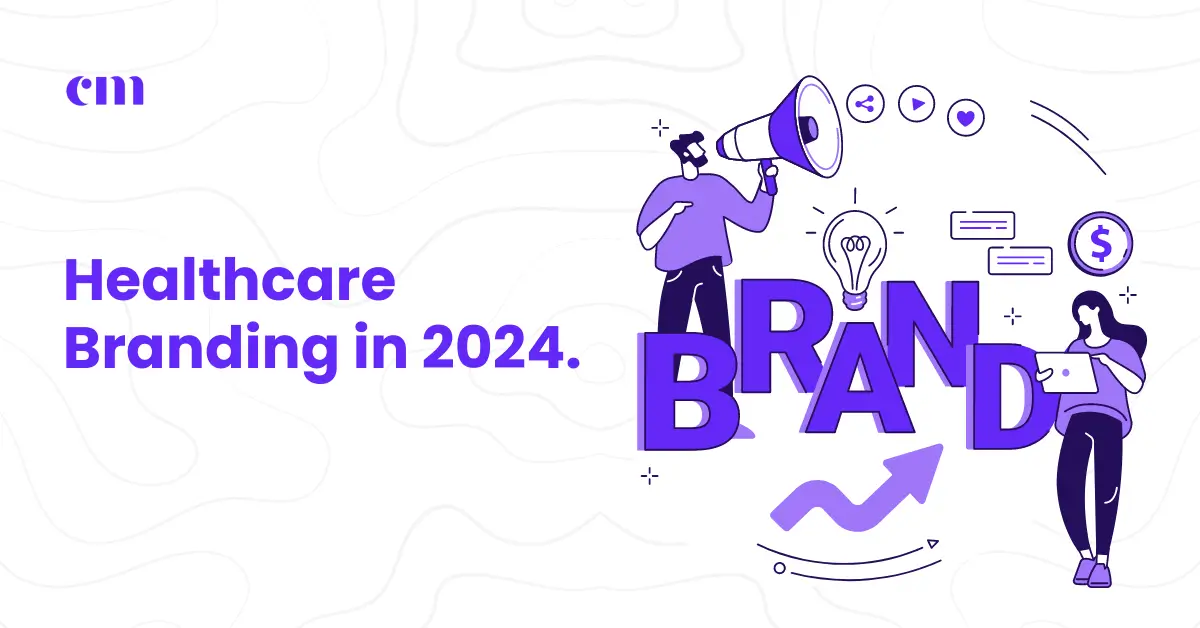In today’s rapidly expanding Indian healthcare sector, standing out from the crowd is more crucial than ever.
Contents
ToggleEach year sees the emergence of new healthcare companies and centers, making it increasingly challenging to differentiate your brand.
However, it’s crucial to find your unique voice in this cacophony of healthcare brands.
Modern patients are discerning. They seek healthcare providers who not only offer superior medical services but also deliver exceptional experiences, incorporate cutting-edge technologies, and demonstrate empathetic care.
Effective healthcare branding plays a pivotal role in evoking these emotions, helping patients connect with your brand on a deeper level.
That’s where healthcare branding comes into play. It’s not just about logos and colors; it’s about crafting an emotional connection with your audience.
It’s about making patients feel valued, understood, and cared for in a way that goes beyond the clinical.
By crafting a strong healthcare brand, you can cultivate long-term patient loyalty and trust, setting the stage for sustainable growth in this competitive industry.
In this guide, we’re going to show you how to create a healthcare brand that not only attracts patients but keeps them coming back for more.
From creating a memorable experience to building trust that lasts a lifetime, we’ve got everything you need to know. So, let’s dive in and discover the power of healthcare branding in 2024!
What is Healthcare Branding?
Well, think of it as the secret sauce that gives your healthcare practice its unique flavor in the eyes of patients and the public.
It’s all about crafting a compelling, professional image that resonates with your audience and sets you apart from the competition.
At its core, healthcare branding is a strategic effort to influence how people perceive and choose healthcare services.
It’s about more than just a logo or a catchy slogan; it’s about creating a meaningful connection with your audience that goes beyond the clinical.
So, what goes into successful healthcare branding? It’s a mix of storytelling, design, identity, and online presence, all working together to shape how your brand is perceived.
A good brand story helps patients connect with your mission and values.
Moreover, meaningful design elements, from your logo to your website, create a visual identity that reflects your brand’s personality and professionalism.
Your website is often the first impression patients get of your practice, so it’s crucial to make it user-friendly, informative, and visually appealing.
These elements, when combined effectively, build trust and loyalty among your audience, ultimately influencing their decision to choose your healthcare brand.
Why Emotional Branding is Vital in Healthcare?
In an ever-growing healthcare landscape, competition among providers is fierce.
Hospitals, pharmaceutical companies, and other healthcare entities are vying for the attention of consumers who have a plethora of choices for their healthcare needs.
This is where strategic emotional branding can make all the difference.
You don’t need a massive budget to create an impactful brand.
What’s crucial is to tap into the empathetic and caring side of your audience, resonating with them on a deeper level.
This kind of branding can significantly boost patient flow and revenue over time, leading to increased profitability, patient loyalty, acquisition, and satisfaction.
Here’s why emotional branding is essential in healthcare:
- Differentiation: Emotional branding helps your healthcare brand stand out from the competition. In a crowded market, having a strong emotional connection with your audience can be the deciding factor for patients choosing your services over others.
- Trust and Loyalty: When patients feel emotionally connected to your brand, they are more likely to trust your services and remain loyal. This can lead to long-term relationships and positive word-of-mouth referrals.
- Improved Patient Experience: Emotional branding can enhance the overall patient experience. When patients feel cared for and valued, their perception of your services improves, leading to higher satisfaction levels.
- Increased Revenue: Ultimately, emotional branding can lead to increased revenue for your healthcare business. By attracting and retaining more patients, you can boost your bottom line and ensure long-term financial success.
5 Key Strategies to Build a Healthcare Brand that Patients Love
It might sound fancy, but hear me out – a strong brand is like a magnet, attracting patients who resonate with your values and trust your services.
No matter if you’re a bustling hospital or a new doctor’s clinic, investing in healthcare branding is a smart move.
It helps you stand out in a crowded market and build lasting relationships with patients.
So, how do you create a healthcare brand that connects on an emotional level? Here are 5 key strategies:
1. Know Your Competition (But Don’t Copy Them)
The healthcare industry is all about patient care, and competition can be fierce.
But here’s the secret: there’s no one-size-fits-all approach. Instead of copying what others do, take some time to research your competition.
Think of it like studying for a big exam – learn from their strengths and weaknesses.
Figure out what gaps exist in the market, where you can truly make a difference.
Maybe there’s a lack of focus on elderly care, or perhaps nobody seems to be addressing the anxiety some people feel at the dentist. This is your chance to shine!
2. Work on Positioning the Brand
Once you understand the competition, it’s time to position your brand. This is about creating a unique identity that sets you apart.
Think about it this way: Let’s say you’re a dentist. Lots of people avoid dental visits because of bad experiences.
In such cases, create a strong brand position around pain-free dental services, which will separate you from other dental companies and encourage everybody to get their dental health checked regularly from your brand.
3. Craft a Brand Identity that Sticks
Imagine your brand as a person. What are their values? How do they speak? What makes them unique?
These are the building blocks of your brand identity. Here’s what you need to consider:
- Your Services: What makes your healthcare offerings special?
- Your Voice: How do you want to communicate with patients? Friendly? Authoritative?
- Your Audience: Who are you trying to reach? Families? Young professionals?
- Your Unique Selling Points (USPs): What sets you apart from the competition?
- Your Values and Purpose: What drives your brand?
Ultimately, your brand identity must become memorable, authoritative, authentic and trustworthy among the consumers or patients.
These aspects can get you thinking about the segments that can differentiate your brand in the industry.
Analyze and get creative with these brand components when creating your brand identity.
4. Tell Your Brand Story
Your brand is more than just a healthcare service provider. It’s a story – a journey that connects with patients on an emotional level.
Articulate a creative and exciting brand story that will make potential consumers interested in your brand and carefully create long-lasting emotions that will encourage them to choose your brand over others.
For example: If your brand focuses on developing cutting-edge medical technologies, craft a narrative around how your innovations are shaping the future of healthcare and improving countless lives. This story will give you a clear edge over competitors who simply provide services without a deeper purpose.
5. Measure Your Success
Building a brand is an ongoing process. Once you’ve developed your healthcare brand, it’s time to see how it’s working!
- Think of it like this: You wouldn’t bake a cake and not taste it, right? Here’s how to measure the impact of your branding:
- Track Your Brand: Monitor online mentions and reviews. Are people talking about you?
- Gather Feedback: Ask patients for feedback through surveys or questionnaires.
- Analyze Results: Use this information to identify areas for improvement and keep building a brand that patients love.
Analyzing these aspects will give you areas to improve and drive more patient satisfaction and loyalty towards your healthcare business.
5 Advantages of Healthcare Branding
It’s 2024 and there is so much competition out there online, if you’re not doing it, then you are actually missing out 100’s of patients.
And most importantly that patient who will Imagine your brand as your hospital’s friendly face – the one that inspires trust, attracts patients, and sets you apart from the competition.
So, why exactly should you invest in healthcare branding? Here are 5 compelling reasons:
1. Building Trust: The Foundation of Healthcare
Think about it: would you trust a surgeon you knew nothing about? Probably not.
The same goes for patients. Trust is the golden thread running through healthcare. People need to feel confident that they’re in the right hands.
Here’s how branding helps:
- Solid Reputation: A strong brand tells a story about your commitment to quality care, expertise, and patient well-being. This translates to trust and reassurance for patients seeking your services.
- Positive Reviews Matter: In today’s digital age, online reviews are like word-of-mouth on steroids. Investing in a positive patient experience – from friendly staff to efficient services – fuels positive reviews, further solidifying your trustworthiness.
2. Standing Out From the Crowd: Don’t Be Just Another Hospital
Let’s face it, the healthcare industry is crowded.
So, how do you make patients choose YOU? This is where branding magic happens!
- Think about this: Are you known for cutting-edge technology? Exceptional bedside manner? Family-friendly care? Your branding strategy should highlight your unique strengths and values. This emotional connection with potential patients sets you apart and makes them choose your brand for their healthcare needs.
3. The Power of Consistency: Inside and Out
Branding isn’t just about fancy logos and snappy slogans.
It’s about creating a consistent experience for everyone who interacts with your brand.
- Imagine it like this: A patient walks into your hospital and sees the same friendly colors and helpful staff they saw on your website. This consistency builds trust and reinforces your brand identity.
- But it goes deeper: A strong brand strategy streamlines internal processes within your hospital. Everyone from doctors to receptionists understands your brand values, leading to a more cohesive and efficient patient experience.
4. Building a Loyal Patient Family
In healthcare, loyal patients are gold.
They’re the ones who keep coming back for checkups, recommending you to friends, and raving about your services online.
So, how does branding help?
- Targeted Communication: Branding helps you define your ideal patient and tailor your message accordingly. This makes patients feel like you understand their needs, fostering a sense of connection and loyalty.
- Positive Experiences Build Loyalty: Happy patients are loyal patients! When patients have positive interactions with your brand, from booking appointments to receiving treatment, they’re more likely to return and recommend you to others.
5. Growing Your Business for the Future
Every hospital wants to expand and serve more patients, right? Here’s where a strong brand comes in handy.
- Think long-term: A well-established brand with a positive reputation attracts investors, strengthens negotiations when expanding into new locations, and ultimately helps you reach more patients in need. This brand value is an investment in your future success.
See How this 9 Medical Organizations Done a Effective Healthcare Branding
1. National Jewish Health: Let Patients Be Your Voice
Imagine a hospital that lets its patients tell the story.
That’s exactly what National Jewish Health, a leading respiratory hospital, does.
Here’s the power move:
- Patient Testimonials: They showcase real stories of patients overcoming challenges and finding hope. This personalized approach paints a picture of a facility that truly cares and gets results.
- Building Trust: By amplifying patient voices, National Jewish Health builds trust and inspires hope for new patients facing similar health battles. This strategy personalizes the “never give up” message and demonstrates their dedication to patient well-being.
2. Banner Health: Infographics for the Win!
Ever feel overwhelmed by long paragraphs of medical information?
Banner Health gets it. They use a powerful tool – infographics – to educate patients about important health topics, like the annual flu season.
Why are infographics so effective?
- Clear & Concise: They present complex information in a visually appealing and easy-to-understand format. This makes it more likely for patients to grasp key points and take action to protect their health.
- Shareable Content: Infographics are perfect for social media. They’re 3 times more likely to be shared and discussed compared to text-heavy articles. This increases brand awareness and empowers patients to make informed decisions.
Banner Health uses infographics to simplify complex topics and make health education fun and accessible.
3. Anne Arundel Medical Center: Social Media Savvy
Social media is a powerful tool for engagement, and Anne Arundel Medical Center knows this well.
During Men’s Health Awareness Month, they launched a creative social media contest.
Here’s the twist:
- Mustache Mania: They encouraged people to post their best mustache selfies for a chance to win a prize. This fun and lighthearted approach sparked a conversation about men’s health while generating excitement and brand awareness.
- Building Community: The contest fostered interaction with a wider audience, attracting potential patients and driving traffic to their website with valuable health resources. This playful approach helped build trust and position Anne Arundel Medical Center as a healthcare provider invested in community well-being.
Anne Arundel Medical Center shows how social media can be used to create a fun and engaging experience while promoting important health messages.
Also read: Why is Social Media Marketing for Doctors Important?
4. Johnson & Johnson: Investing in the Future
Johnson & Johnson, a household name in healthcare products, takes a long-term view of branding.
Recognizing nurses have brought innovation to patient care that has profoundly changed human health, they launched a unique outreach project.
Because nurses change lives.
Here’s their solution:
- Nurses Change Lives Campaign: They created a wealth of educational resources like videos, podcasts, and articles to inspire and support future nurses. Sharing “day-in-the-life” stories adds a personal touch, allowing viewers to connect with the challenges and rewards of a nursing career.
- Double Benefit: This campaign not only supports the nursing workforce, but also fosters trust with patients who rely on these skilled professionals for their well-being.
Johnson & Johnson understands that investing in the future of healthcare benefits both patients and the industry as a whole.
5. Floating Hospital for Children at Tufts Medical Center: Building a Support System
For parents whose children are receiving medical care, the journey can be isolating.
The Floating Hospital for Children at Tufts Medical Center recognized this need and created a special online community – exclusively for moms.
Why is this so powerful?
- Moms Supporting Moms: Mom groups are a powerful force on social media. By creating a safe space for moms to connect and share experiences, the hospital shows empathy and understanding. This emotional connection fosters trust and creates a valuable support system for these families facing challenges.
The Floating Hospital for Children goes beyond medical care – they cultivate a community of support that empowers parents during a difficult time.
6. Mayo Clinic: Knowledge is Power
Remember that trusted friend who always seems to have the answer?
That’s the vibe Mayo Clinic cultivates. Ranked as the best hospital in the US by U.S.
News and World Report, they’ve built a powerful brand by becoming a go-to source for reliable medical information.
Here’s what makes them shine:
- High-Quality Content: They create tons of informative articles, videos, and podcasts written by doctors and patients. This diverse perspective offers a personalized view of diagnoses, treatments, and the road to recovery.
- Open Communication: They actively engage with their audience by hosting live Q&A sessions with medical professionals. These sessions allow patients to ask questions and feel heard, while also creating a valuable digital archive of information.
By prioritizing knowledge sharing, Mayo Clinic empowers patients and builds trust – a winning brand strategy.
7. Columbia Health: Growing the Next Generation
Think beyond today’s patients – Columbia Health is setting their sights on the future!
Their “Go Ask Alice!” online forum and blog platform caters specifically to young people.
Why is this smart?
- Safe Space: It provides a judgment-free environment for teens and young adults to ask questions about their health. This open dialogue breaks down barriers and encourages proactive health awareness.
- Future Healthcare Heroes: By fostering a supportive community around health information, Columbia Health sparks interest in the healthcare field. Who knows, maybe some of these young minds will become the next generation of doctors and nurses!
Investing in young people’s health education is a smart way for Columbia Health to build a strong brand with long-term impact.
8. Hartford Healthcare: Making Convenience Key
Let’s face it, nobody enjoys needing urgent care. Hartford Healthcare understands this and uses it to their advantage when building their brand.
Here’s how they do it:
- Short & Sweet Videos: Using catchy 30-second videos, they showcase how easy it is to book appointments with qualified doctors through their website and app.
- Focus on Patient Needs: They address the key concerns patients have – convenience and quality care. By showing how effortless it is to access their services, Hartford Healthcare builds trust and positions itself as the go-to option for urgent care needs.
Focusing on patient convenience is a smart way for Hartford Healthcare to stand out in a competitive market.
9. Zocdoc: Promoting Wellness, Not Just Sickness
Doctors are there to treat illness, but preventing it is even better! Zocdoc, an online appointment booking service, understands this philosophy.
They launched a unique campaign called “Unsick Days.”
What’s the message?
- Preventive Care Matters: The campaign encourages patients to schedule appointments during their healthy times, not just when they’re feeling unwell. This proactive approach to health management empowers patients to take control of their well-being.
- Win-Win Situation: “Unsick Days” benefits both patients and doctors. Patients can address potential health concerns before they escalate, and doctors can focus on preventive care and maintaining patient health.
Zocdoc’s campaign highlights the importance of preventive care and positions them as a partner in a patient’s overall health journey.





